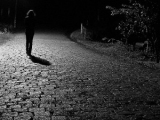 If you have an eating disorder you live a life that is more dangerous than you know. Your eating disorder behaviors are only part of the risks you experience every day.
If you have an eating disorder you live a life that is more dangerous than you know. Your eating disorder behaviors are only part of the risks you experience every day.
You can feel safe but be in danger. You can feel afraid and be in danger. Your felt fear can help you recognize the source of danger and take action to make yourself more realistically safe.
If you binge or purge or starve or compulsively eat you can ease or ward off entirely, your feelings of anxiety. You know this. You may prefer to live in this more emotionally blocked state even though the methods you use to achieve this relief from intolerable stress can create dangerous situations.
When you reach for immediate comfort to block your fear you also block your ability to perceive sources of danger. If you live in this emotionally blocked way you can unconsciously or consciously accept a large degree of potentiial and real danger in your daily life.
Here are a few high-risk situations that may be familiar to you.
High Risk Home Environment
You live alone in an apartment or a condo. You are numb to a sense of anxiety that might come if you let her awareness awaken to the physicality of her environment.
- Your parking is not secure. You may have to walk a block or more to reach your front door. You may park in an underground parking structure that is not well lit, not secure and leaves you exposed to predators.
- The entrance to your building is dark and shrouded with bushes. Perhaps you walk up or down a dark staircase or move through a pathway turn that makes you invisible to others.
- Your rooms are on the ground floor with unsecured windows facing a public walkway.
When you live in any one of these circumstances you will feel a low-grade sense of anxiety most of the time but not attribute your feelings to your vulnerable situation at home.
You may criticize yourself for feeling a bit anxious coming home. You may feel shame when you run to your front door. Worse, and this is often the case, you are oblivious to the safety flaws in your environment . Then you accept as normal activities and events that even raise the level of potential danger.
If you are followed home (because of other unappreciated risk factors in your life) the predator or stalker following you would have little difficulty in approaching you under these minimal secure conditions.
Certainly driving home alone after dark and then walking some distance to your front door and/or walking through an area where a predator can lurk creates a dangerous vulnerability.
Safety Relates to Eating Disorder Recovery
Recovery from an eating disorder involves creating a safe and secure container from which to do the psychological work necessary for healing.
Usually this is discussed in terms of the therapeutic alliance and the treatment itself. This is valid. But the early stages of psychotherapy and recovery from an eating disorder also involve creating a secure space or correcting a fragile space in your external world.
You need to be able to live reasonably safe from danger so you are more free to feel and progress on your healing path. Also, in creating safety for yourself, you can begin to learn that some of your fears are justified.
Psychologically, this is good news. It means you can appreciate that you are not weak, crazy or over sensitive. Your fears are based on reality.
When your fears help you acknowledge realistic danger they also inform you about what positive and self-protective action you can take on your own behalf.
This can be the beginning of developing confidence and trust in yourself. You draw on your power, not to move into an eating disorder episode, but to genuinely care for yourself. This can be the beginning of solid recovery.
Well-lighted pathways, secure parking and other safe conditions are far more effective in keeping a person safe than any binge or purge or compulsive eating activity.


Add comment